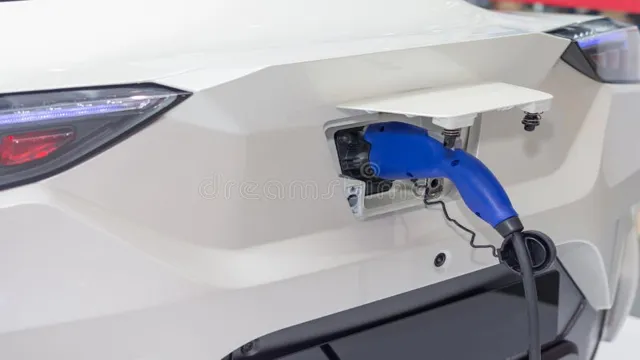Amp Up Your Ride: Boosting Electric Car Battery Charging Efficiency
Electric cars have become increasingly popular due to their numerous benefits, including their environmental friendliness and reduced operating costs. However, one of the greatest challenges that electric car owners face is finding an efficient and reliable way to charge their vehicles. With the increased adoption of electric vehicles, it has become crucial to develop effective systems for electric car charging.
This is where data-driven solutions come in handy. Efficient electric car charging solutions rely on data analysis to identify charging patterns and determine the ideal charging times and conditions. Thanks to innovative technologies, data can now be collected and analyzed in real-time to optimize electric car charging efficiency.
This means that charging stations can now be conveniently located, and electric car owners can be confident that their vehicles are always fully charged when they need them. This blog post aims to offer a data-driven guide to help electric car owners navigate the complex world of electric car charging. We will explore the various aspects of electric car charging, including the different types of charging stations, the key factors that impact charging efficiency, and tips on how to optimize charging times.
Whether you are a seasoned electric car owner or a new enthusiast, you will find valuable information that will help you get the most out of your electric car. So, sit back, relax, and let’s delve into the exciting world of efficient electric car charging.
Understanding charging efficiency
Electric car battery charging efficiency is an important factor to consider when deciding on purchasing an electric vehicle. It refers to the amount of energy that can be stored in an electric car battery and how efficiently it can be charged. The charging efficiency can be influenced by several factors that affect the power flow.
The charging infrastructure, battery size, age, and temperature, and the charging speed all play a significant role in determining the battery charging efficiency. Additionally, the battery charging efficiency can also be affected by the type of charging method used such as DC fast charging, level 2 charging, or wireless charging. It is important to optimize the battery charging process to ensure its longevity and a sustainable driving experience.
High-speed charging can cause the battery to overheat or degrade prematurely, leading to shorter driving ranges. Therefore, understanding the charging efficiency of your electric vehicle’s battery can help maximize its potential and provide a reliable driving experience.
Breaking down charging efficiency metrics
Charging efficiency is an essential metric when it comes to electronic devices, especially those that rely on batteries. It refers to how much energy is lost during the charging process. In simple terms, the higher the charging efficiency, the less energy is wasted.
This metric is calculated by comparing the amount of energy stored in the battery to the amount of energy used to charge it. An efficient charging process requires minimal heat generation during the charging cycle. This helps to prevent overheating and prolong the battery’s lifespan.
Therefore, it is important to consider charging efficiency when choosing chargers for your electronic devices. By doing so, you can ensure optimal performance and longer battery life.

Examining the impact of charging equipment
When it comes to electric vehicles, the charging efficiency is a crucial factor to consider. A common misconception is that all charging equipment is created equal, but this is not the case. The impact of charging equipment on charging time and energy efficiency is significant.
Level 1 chargers, which use a standard 120-volt outlet, are the slowest and least efficient when it comes to charging an electric vehicle. Level 2 chargers, which use a dedicated 240-volt circuit, are much faster and more efficient. The fastest and most efficient charging option is a Level 3 charger, also known as a DC fast charger.
This type of charger can charge an electric vehicle up to 80% in just 30 minutes. It’s important to consider the type of charging equipment you have access to and plan accordingly for long trips. Remember, not all charging equipment is created equal, and choosing the right one can have a significant impact on your EV experience.
The role of battery capacity
When it comes to electric car battery charging efficiency, the role of battery capacity cannot be ignored. Having a larger battery capacity generally means that it can store more energy, allowing the car to have a longer driving range before needing to be charged. However, a larger battery capacity does not necessarily mean faster charging times.
In fact, a larger battery may take longer to charge due to the need for more electricity to fill it up completely. On the other hand, a smaller battery may charge faster, but its limited capacity means that it may not be able to travel as far before needing to be charged again. Ultimately, the key is finding a balance between battery capacity and charging efficiency for optimal performance.
How battery size affects charging efficiency
Battery size plays a significant role in the charging efficiency of electronic devices. Generally speaking, larger batteries have a lower charging efficiency than smaller ones. This is because larger batteries have a higher capacity and require more energy to charge fully.
As a result, charging a bigger battery may take longer and require more power from the charging source. Conversely, smaller batteries can often be charged more quickly and efficiently, since they require less energy and time to charge. It’s worth noting that the charging efficiency may also depend on the type and quality of the battery, as well as the charging method used (e.
g. wired vs. wireless charging).
Therefore, it’s important to consider the battery capacity when choosing a device and its charger, as well as to follow the manufacturer’s recommendations for optimal charging practices.
Analyzing the impact of temperature
When it comes to analyzing the impact of temperature on batteries, the role of battery capacity cannot be overlooked. Battery capacity refers to the amount of charge that a battery can hold, and it can vary depending on the type of battery and its manufacturer. Higher battery capacity means that the battery can provide more power for a longer period of time.
However, when exposed to high temperatures, battery capacity can significantly decrease, which can hamper the performance of a device. This is because high temperatures can damage the internal structure of a battery, reducing the number of active materials available for charge storage. As a result, the battery’s ability to hold and deliver charge diminishes, requiring more frequent charging and leading to a shorter lifespan.
So, it’s important to keep batteries at moderate temperatures to prevent damage and maximize their capacity. By doing so, we can ensure that our devices can run smoothly for longer periods without the need for frequent charging, which ultimately saves us time and money.
The importance of proper battery maintenance
When it comes to proper battery maintenance, it’s crucial to understand the role of battery capacity. Battery capacity refers to the amount of energy a battery can store, and it’s an essential factor in determining how long your device will last on a single charge. It’s important to note that as a battery gets older and is repeatedly charged and discharged, its capacity will naturally degrade.
That’s why it’s important to take steps to maintain your battery’s capacity, such as avoiding extreme temperatures, using the correct charger, and not overcharging or completely draining your device. By taking care of your battery’s capacity, you’ll be able to keep your device running smoothly and reliably for longer, saving you money and avoiding the frustration of sudden battery failures.
Measuring real-world efficiency
When considering the efficiency and practicality of electric cars, the battery charging process is a crucial factor to evaluate. Electric car battery charging efficiency measures how much energy is being transferred from the charging station to the car’s battery during each charging session. This metric is critical in evaluating electric car models, as faster charging and higher efficiency mean that the car can travel more miles on a single charge.
Moreover, efficient battery charging can help reduce the car’s impact on the environment, as more electric miles mean fewer greenhouse gas emissions. Therefore, an electric car’s battery charging efficiency can be measured as a metric for both practicality and sustainability.
Comparing charging protocols and standards
When it comes to comparing charging protocols and standards, it’s not just about theoretical efficiency, but also real-world performance. One of the most commonly used protocols is CHAdeMO, which was developed by a group of Japanese automakers. While it provides fast charging, it’s not as widely available as other protocols and may not be the most efficient in terms of energy transfer.
On the other hand, CCS (Combined Charging System) is widely adopted in Europe and is becoming increasingly popular in North America. It provides a combination of AC and DC charging for maximum flexibility and efficiency. Tesla’s Supercharger network uses its own proprietary protocol, which provides fast charging speeds but is only compatible with Tesla vehicles.
It’s important to consider not just the raw charging speed but also the practicality and availability of different protocols when choosing a charging station. Ultimately, the goal is to make charging as seamless and convenient as possible for EV drivers.
Examining charging networks and infrastructure
As electric vehicles become more popular, the need for reliable charging infrastructure is becoming increasingly important. While many charging networks exist, not all are created equal. Efficiency in these networks is a major concern for EV owners, as time spent waiting for a charge can be frustrating.
Real-world efficiency measurements give owners a better understanding of which networks provide the best charging experience. These measurements take into account factors such as the number of charging stations available, the speed of the charging network, and the location of the charging stations. The most efficient networks offer a reliable and fast charging experience, allowing EV owners to spend more time on the road and less time waiting for a charge.
Future developments in charging technology
Electric car battery charging efficiency is constantly evolving, and future developments in charging technology are expected to make charging faster and more convenient. Wireless charging pads, for example, are already being incorporated into some electric vehicles, allowing for a hassle-free charging experience. Additionally, advancements in battery technology, such as solid-state batteries, may allow for faster charging times and longer range.
Another promising development is vehicle-to-grid (V2G) technology, which allows electric cars to not only draw power from the grid but also return it, providing an opportunity for car owners to earn money by selling excess energy back to the grid. As electric cars become more common, the need for innovative and efficient charging solutions will only increase, leading to even more exciting developments in the future. So, get ready for a time when charging electric cars will be as commonplace as charging smartphones.
Conclusion
In conclusion, the efficiency of electric car battery charging can be likened to a marathon runner trying to conserve energy. Just as the runner paces themselves and strategically plans when and how much to drink fluids during the race, electric car owners need to carefully manage their charging habits to maximize efficiency. By utilizing smart charging techniques and taking advantage of renewable energy sources, the electric car battery charging process can be optimized for both performance and sustainability.
So let’s all strap on our running shoes (or plug in our electric cars) and strive to cross the finish line with maximum energy and a smile on our faces!”
FAQs
What is electric car battery charging efficiency?
Electric car battery charging efficiency refers to the amount of energy that is converted from the electricity source to the battery during charging. It is usually expressed as a percentage and can vary depending on the charging method and equipment used.
How can charging efficiency affect the range of an electric car?
A lower charging efficiency means that more energy is lost during charging, which can result in a shorter driving range. This is because less of the energy from the electricity source is actually stored in the battery.
What factors can affect electric car battery charging efficiency?
Factors that can affect charging efficiency include the age and condition of the battery, the type and quality of the charging equipment used, the temperature of the battery during charging, and the charging rate or speed.
Are there ways to improve electric car battery charging efficiency?
Yes, there are several ways to improve charging efficiency, such as using high-quality charging equipment, avoiding charging in extreme temperatures, and charging more frequently with smaller amounts of energy rather than waiting for the battery to fully discharge before charging. Additionally, some electric cars have regenerative braking systems that can help to recapture energy during driving, which can then be used to charge the battery.






